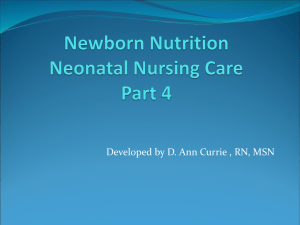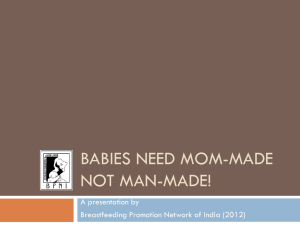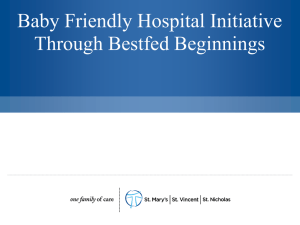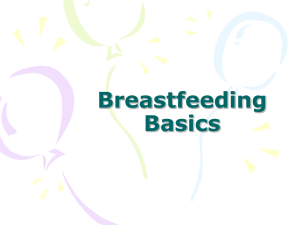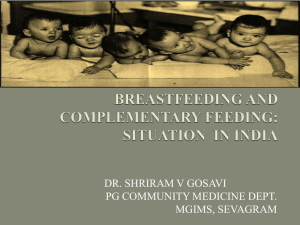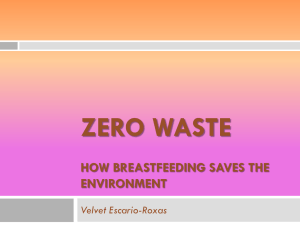Hiltrud`s Presentati.. - Best Start Resource Centre
advertisement
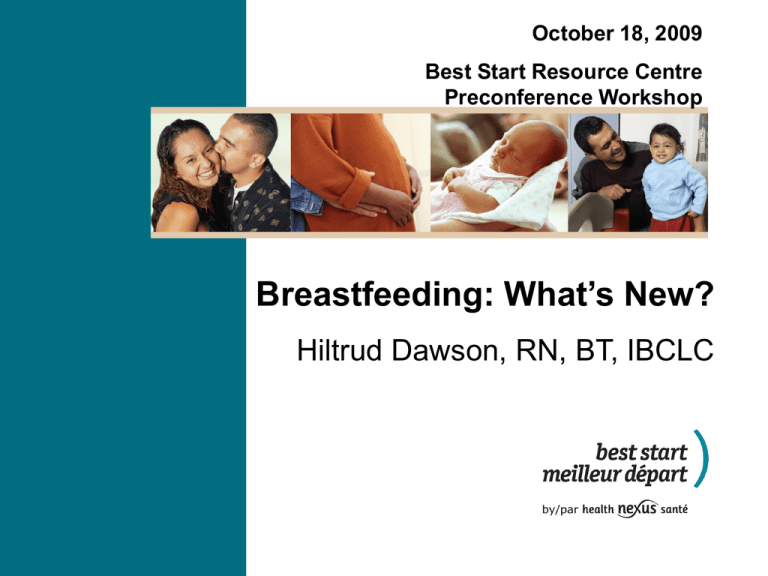
October 18, 2009 Best Start Resource Centre Preconference Workshop Breastfeeding: What’s New? Hiltrud Dawson, RN, BT, IBCLC The Best Start Resource Centre • Provides: – – – – Networking Consultations Training Resources • Is a key program of Health Nexus • Is funded in part by the Ministry for Children and Youth Services The Best Start Resource Centre Breastfeeding Resources Healthy Mothers Healthy Babies breastfeeding web course 2-sided desk reference poster desk reference on drinking alcohol and breastfeeding fridge magnet Many other resources with breastfeeding information List of available or adaptable breastfeeding posters and displays from other organizations Topics 1.Pathways to Plenty 2.Gadgets to Achieve Goals 3.Language and Practices that Promote Pathways to Plenty • Mammogenesis and lactogenesis • Capacity, volume and intake • Maternal and infant variables • Effective practices • Skin-to-skin • Manual expression • Baby-led latching Objectives • Identify key markers of sufficient milk production and transfer • Review effective strategies that promote sufficient milk production and transfer Mammogenesis • Fetus – Milk line from groin to axilla – By birth breast tissue with nipple located on both sides of chest • Puberty – Growth of breast – Growth of ductal system, nipple and areola • Early Pregnancy – Enlargement of breast, nipple and areola – Darkening of areola – Increased blood supply and warmth (Neville et al., 2002) Lactogenesis Stage I • Mid to late pregnancy – Production and secretion of colostrum – By the end of pregnancy: 30 mls per day Arthur et al.,1991; Cowie 1980; Cox et al 1999 • After birth (up to 36 – 72h) – Secretion of colostrum – Increased warmth and size Lactogenesis Stage II • Onset of copious secretions of all milk components (Milk Synthesis) • Occurs after birth in response to the decline in pregnancy hormones • Causes changes in absorption of nutrients as colostrum changes to mature milk • Lasts for a few days starting about 36 – 72 hours post birth (biology of lactation: 342 – 460B; McGill University) Galactopoeisis • Maintenance of milk production • Regulated by hormones and mammary factors • Hormone control changes from endocrine to autocrine (biology of lactation: 342 – 460B; McGill University) • The baby is now in the driver’s seat Prolactin birth conception Not to scale Progesterone 16 – 22 w Mammogenesis 36 – 72 h Lactogenesis I Endocrine (hormonal) control Adapted from Kellymom.com, 2004 L II Galactopoeisis Autocrine (local) control Autocrine Control – How Does the Baby Drive the Milk Production? • Sucking stimulus – nerve endings in nipple areolar complex – stimulates Prolactin • Mother-Baby contact – skin-to-skin contact and feeding – releases Oxytocin • Alveolar stimulus – cell/breast emptying – decreases Feedback Inhibitor of Lactation How Much Milk is Produced? • Shortly after feeding (emptying) the alveloar cells are at maximum secretion • As the intra-mammary pressure increases the rate of secretion (production) slows down • At some point the pressure is high enough to slow production to zero and reabsorption of milk begins Stomach Capacity and Milk Volume Day 1. 2. 3. 4. 5. Capacity 5 – 7 mls 10 – 13 mls 22 – 27 mls 36 – 46 mls 43 – 57 mls Milk Volume/day 10 – 100 mls 200 mls >400 mls >600mls Daly SEJ & Hartmann PE J Hum Lact 11:21-3 (1995) Post Partum Secreted Ingested Per Feed First 24hrs First 36hrs 7-14ml 49-96 hours Day 5 1-6 Months 7-123ml Gradual increase Dramatic increase 500ml / day Hartman 1987 Houston et al 1983 45-60ml 750-800ml/day Approx. 90150ml Daly Owens & Hartman 1993 / 95 Kent et al 2006 Average Milk Intake of Babies 5-10 ml 15 – 25 ml 30 – 45 ml 60 – 80 ml Maternal Variables • • • • • • Anatomy, breast milk storage capacity Genetics, surgery, injury … Attitude, knowledge and comfort level Body image Self-efficacy Support network Photo by Flickr Infant Variables • • • • • Gestation, maturity, age Anatomy Temperament State control Appetite Photo by Traci Nelson 3 Keys to Success • Mother and baby together • Feed the baby • Stimulate the milk supply Poster by Attie Sandink Early + Often + Effective = Exclusive Plan: Feed the baby (Protect the baby) Move the milk (Promote the supply) Essence of time (Support the dyad) What Works? • Frequent and effective feeding • Manual expression • Skin-to-skin Picture from www.mama-knows.com Baby-led Latching • • • • Calm, relaxed mother Quiet, alert baby Vertical position, skin-to-skin Pelvic girdle stability and shoulder girdle stability • Time, coaching, and assisting/aligning as needed Research from Dr. Christina Smilie Baby-Led Latching Video • http://www.motheringtouch.ca/node/66 Skin-to-Skin Benefits • Benefits – Term and pre-term babies – Breastfeeding and not breastfeeding babies • Stable temperature, heart rate, respiratory rate • Better physical adaptation to extra-uterine life • Cry less • Sleep better • Gain weight better More exclusive breastfeeding More supplementation 0h 3h More skin-to-skin contact right after birth Bramson et al., 2010 Skin-to-skin Video • http://collections.stfx.ca/abigelow/skin_to_s kin/skin_to_skin.parents.mp4 Results from Study • Longer breastfeeding duration • Increased mothers’ sensitivity to baby • Decreased feelings of postpartum depression • Increased babies’ quiet alert state and attentiveness • Enhanced babies’ responsiveness Bramson et al., 2010 Photo by Traci Nelson Manual Expression Benefits of Manual Expression • Empowers the mother • Increases available colostrum • Increases milk production Manual Expression • http://newborns.stanford.edu/Breastfeeding /HandExpression.html Gadgets to Achieve Goals • Breastfeeding goals • Supplementary feeding • Pumps and gadgets What Do Mothers Want? What Do Mothers Want? Breastfeeding Goals • Exclusive breastfeeding for 6 months • Continued breastfeeding for up to 2 years • The decision to breastfeed is usually made before pregnancy or in the early part of pregnancy • Goals are more flexible and fluid and depend on past and present experience, the mother and her available support What Impacts or Derails the Goals • Birth – preterm, maternal or infant complications • Postpartum - maternal factors – Fatigue, bf problems, self-efficacy, • Postpartum – infant factors – Bf problems, weight loss • Postpartum – external factors – Hospital practices, information, support Who Needs Help? • • • • • • Low education Lack of social support Younger age Growing up in a non-breastfeeding culture History of breastfeeding difficulties Maternal or infant factors post birth Examples • Mother A – gives birth to a full term baby. Everything goes well until day 11 when her physician or nurse discovers that the baby is not gaining weight and is still 10% below birth weight. • Mother B – gives birth to a full term baby following a placental abruption. The baby needs special care initially then joins mother in her room, but will not latch and feed. • Mother C – gives birth to a pre-term baby at 28 weeks. After her discharge she returns to her home 3 hours drive from Thunder Bay while the baby remains in NICU. Pumps and Gadgets - Why • To keep mother and baby together • To feed baby • To stimulate or increase milk supply Ultimate goal • Breastfeeding success! Supplements • Strongest predictor of breastfeeding failure or premature weaning • Why supplement? • Why NOT supplement? • What to supplement? • How to supplement? • Building confidence Global Strategy for Infant and Child Feeding Infants who are not breastfed, for whatever reason, should receive special attention from the health and social welfare system since they constitute a risk group.” WHO (2003) What to Supplement? • Mothers own EBM or colostrum • Donor pasteurized human milk • Artificial baby milk (cow’s milk-based formula, soy-based formula) Informed Decision Making • “Enabling parents to make fully informed decisions about infant feeding by providing them with accurate, evidence-based information. Information should be provided early in the pregnancy to allow sufficient time for questions and dialogue.” BFI in CHS: A Canadian implementation guide – glossary p83. Cup or Spoon Feeding Finger Feeding From Kathy Venter Lactation Aid at the Breast From Kathy Venter Nipple Shield From Kathy Venter Bottle Feeding Australian Breastfeeding Association A caregivers guide to the breastfeeding baby Breast Pumps Use pumps carefully: right pump for the purpose right size horns right vacuum pressure right timing right frequency From Kathy Venter Breast Pumps - Electric Hospital grade & personal use Breast Pumps - Manual Building Confidence • • • • • Good assessment 3 key points Least intervention to achieve goal Positive images and language Ongoing support References • Auerbach, K & Riordan, J. (1999) Breastfeeding and Human Lactation. MA. Jones and Bartlett • Canadian Institute of Child Health. (1996) National Breastfeeding Guidelines for Health Care Professionals. Ottawa; Author: P20-22. • Consultant’s Corner: When Is Supplementation Necessary for the Breastfed Infant? JHL 1998; 14:143-149. • Health Canada. Family Centered Maternity and Newborn Care: National Guidelines, Minister of Public Works and Government Services. Ottawa 2000. P7.22. • IlCA. (2005) Evidence Based Guidelines for Breastfeeding Management During the First Fourteen Days. • WHO. (2003) Global Strategy for Infant and Child Feeding. WHO, UNICEF, Geneva Language and Practices that Promotes • Effective communication • Informed decision making • Ethical practices • Breastfeeding promotion The Message • Words • Tone of voice • Other sounds • Facial expressions • Body language The Recipient • What is on her mind? – During pregnancy – Postpartum Learning a New Skill • Volunteer demonstration The 3 Phases of the Postpartum Period Taking In 2 - 3 days Taking Hold 3 - 14 days Letting Go 15 days – 6 m Needs to discuss birth Needs to discuss expectations and reality Needs to discuss and understand role Vulnerable, feels like a Vulnerable to victim rejection, mood swings Lean on experts, strong need to be mothered Health Canada, 2000 Recognizes baby’s dependence, still needs to be mothered Vulnerability declines, integrates experience, begins to feel able to cope Needs peer acceptance, onset of empowerment Informed Decision-Making • Exploration of bias, concerns, beliefs … • Accurate and consistent information • Conveying value Best Start Inc.’s 3-Step Counselling Program Bryant & Lindenberger, 2000 Step 1 • Ask open-ended questions about breastfeeding? Step 2 • Affirm the mother’s feelings Step 3 • Share appropriate information and refer the mother to a breastfeeding expert 5 Husbands, 1 Wife and 1 Good Friend Ethical Practices • Formula manufacturers ~ food manufacturers • The WHO Code • Subsequent WHA resolutions • Global Strategy for Infant and Child Feeding • Breastfeeding in Emergencies Ethical Principles • • • • • Non maleficence Beneficence Autonomy Justice Professional/patient relationship Breastfeeding Promotion • Accurate and consistent information • Individual information • Special attention to “at risk” moms and babies • Placing the right value on breastfeeding 3 Messages to Keep in Mind • Breast is NOT Best • Formula is NOT Second-Best • It is NOT Only Mothers Who Breastfeed Akre, 2010 Normal Body Functions • • • • • • Blood pressure Blood sugar Bone density Kidney function Blood cell count Lung function Marketing Outcome Evidence Promotion Promote breastfeeding! • Normalize breastfeeding by the way you communicate. Thank You! Hiltrud Dawson Best Start: Ontario’s Maternal, Newborn and Early Child Development Resource Centre Phone: 416-408-2249 or 1-800-397-9567 ext 2250 h.dawson@healthnexus.ca www.beststart.org

